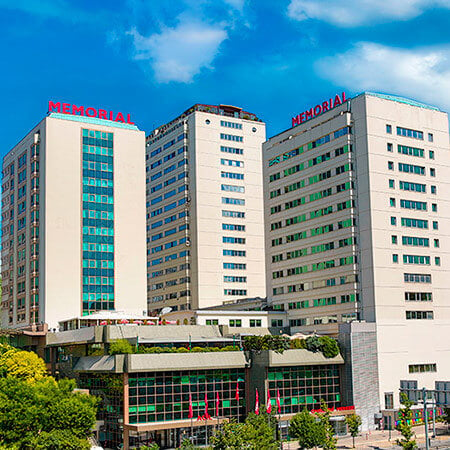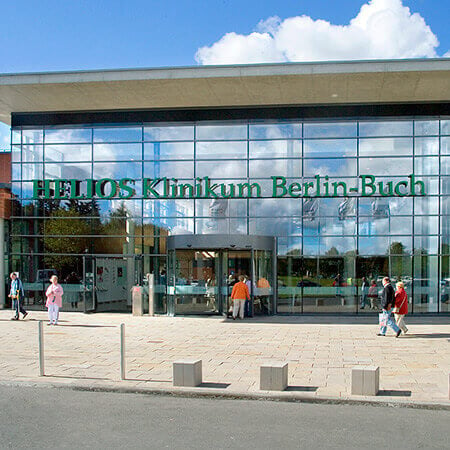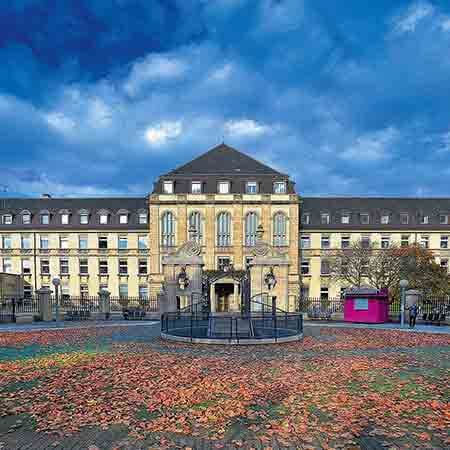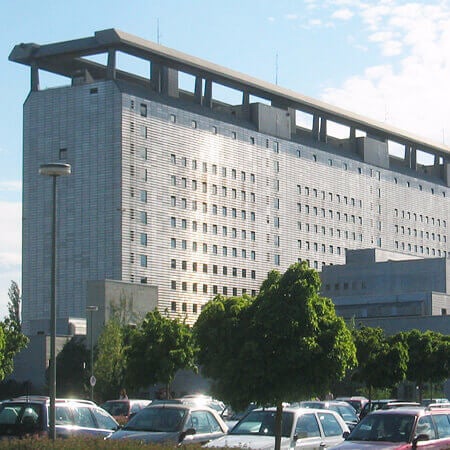Acute myeloblastic leukemia (AML)
Due to the difficulties associated with the organization of treatment in Turkey, Switzerland, South Korea and India, we are not currently processing requests to these regions.
If you are interested in treatment in Germany, please leave a request and our specialists will contact you as soon as possible.
Acute myeloblastic leukemia (AML) is a malignant blood disease. It is referred to non-lymphoblastic leukemia and makes up about 90% of this disease group structure. Tumors develop from hematopoietic tissue with a primary lesion of the bone marrow. Morphological substrate of the malformation is the blast cells called myeloblasts. The average age of the patients is 67, although the pathology can develop at any age, including children.
The Booking Health portal presents 51 German clinics specializing in acute myeloblastic leukemia (AML) treatment
Show all clinics
Acute myeloblastic leukemia (AML) – Diagnostics
Diagnostics starts with the complete blood count . The doctor usually detects the following changes:
- Low red blood cell and hemoglobin count
- Low platelet count
- Low or high white blood cell count
Bone marrow puncture is performed on the basis of the symptoms present and the complete blood count. Bone marrow puncture is the main method of diagnostics in case of leukemia. The diagnosis is established if more than 20% of blast cells are present. Histologic form of acute leukemia is defined with the help of biopsy sample.
Primary diagnostics is performed not only with the help of a puncture. This method allows to assess the effectiveness of the treatment:
- Reduction of blast cells down to 5% indicates a complete clinical remission
- The intermediate state (5-20% blast cells) is called partial clinical remission
- If the number of blast cells increases up to 5%, it indicates a possible relapse in the nearest future
- The presence of more than 20% of blast cells in the bone marrow puncture indicates a relapse of the disease
Additional methods of the diagnostics. Other diagnostic methods are used to determine the amount of the tumour cells, assess the internal organs function, reveal the foci of the extramedullary leukemic infiltration.
The following methods are used for this purpose:
- Imaging methods, such as ultrasound examination, X-ray, CT, MRI
- Lumbar puncture (cerebrospinal fluid is taken for analysis)
- Blood biochemistry analysis is performed to determine the activity of the tumour
Best clinics for the acute myeloblastic leukemia (AML) diagnostics in Germany:
Acute myeloblastic leukemia (AML) – Treatment
Chemotherapy is the basic treatment method. Bone marrow transplantation may be performed in the young age. Concomitant therapy is also very important. It supports the vital activity of the patient and ensures an acceptable quality of life.
- Induction chemotherapy. Drugs that block the growth of tumour cells are prescribed. The purpose of the treatment is to achieve a hematological remission.
- Consolidation is the treatment that a person receives during the remission period. Relapse of the acute myeloblastic leukemia occurs within several months if the consolidation is not used. Therefore, the purpose of the consolidation treatment is to prevent the relapse.
- Stem cells transplantation is one of the consolidation options. This operation is more preferable if the age of the patient is less than 30. It is indicated, if the adverse prognostic factors of the acute myeloblastic leukemia (brain damage, a very high white blood cell count) are present.
- Autologous transplantation (own stem cells) or allotransplantation (biological material from a donor) is used in this procedure. Stem cells transplantation significantly improves the survival of patients in the long term perspective, but there is a risk of complications, including fatal one. Allogeneic transplantation carries more risks, but this treatment gives the patient a chance of a complete cure from the disease.
- Nonmyeloablative transplantation is the type of allogeneic transplantation, which doesn’t presuppose the complete bone marrow destruction by the radiation and chemotherapy. It is better tolerated and rarely provokes any complications.
- Supporting therapy is aimed at the normalization of blood parameters and includes red blood cell and platelet concentrate transfusions, prevention and treatment of neutropenic complications.
- Leukapheresis refers to the supportive therapy. It is performed during the first days after the establishment of a diagnosis. The procedure is aimed at reducing the number of leukocytes in the blood.
Acute myeloblastic leukemia (AML) – Innovative treatment
The disadvantage of acute myeloblastic leukemia chemotherapy in the elderly is a significant number of side effects. Sometimes such treatment reduces, but not increases, the life expectancy. Besides, chemotherapy is badly tolerated and worsens the life quality of the patient. That's why, the development and testing of new medicines, more benign, which can be used in elderly people with concomitant somatic pathology, are constantly being performed.
The following medications are:
- Sapacitabine
- Laromustine
- Tipifarnib
Immunotherapy methods are gradually introduced into the clinical practice.
Part of the techniques below is already used for certain leukemia types, the other part is still at the clinical trials stage.
- Monoclonal antibodies. These are the immunoglobulins that contain the cell toxins. The toxins destroy tumor cells after the injection into the body and the attachment of antibodies to cancer cells.
- Checkpoints inhibitors block the signal molecules on the surface of atypical cells, which protect them from the influence of the human immune system. As a result, the immune system starts to destroy tumour cells.
- CAR T-cell therapy is the newest method of immunotherapy. T-cells are taken from the patient’s blood and then changed in the laboratory conditions. As a result, the attachment of the T-cells to tumor cells becomes possible in the human body. T-cells are taken only once from the patient’s blood. Further, they are cultured in laboratory conditions and can be used to treat AML for a long time.
Best clinics for the acute myeloblastic leukemia (AML) treatment in Germany:


Memorial Sisli Hospital Istanbul

Helios Hospital Berlin-Buch
Acute myeloblastic leukemia (AML) – Rehabilitation
Most patients require rehabilitation after the treatment of complex oncological diseases. It includes the following aspects:
- Prevention of complications that may occur as a result of treatment. It can be pneumonia, lymphostasis, thromboembolic or infectious complications.
- Restoration of general health. The elimination of the consequences after surgeries and chemotherapy is carried out. The functions of internal organs are restored with the help of various medical and rehabilitation measures.
- Restoration of occupation. A person must not just stay alive. He must have physical and intellectual capabilities, which are sufficient for employment.
- Psychological support. First of all, it is required for patients, whose occupational performance was harmed because of the disease. Patients with deterioration of appearance also will benefit from psychological help.
- Restoration of appearance. If necessary, you can use surgical and other methods in Germany to restore appearance defects caused by cancer. For example, to carry out the reconstruction of the breast.
- Social and domestic rehabilitation. A person with reduced workability is trained to act in the society and perform everyday tasks in new conditions.
In German clinics, rehabilitation is carried out in a comprehensive manner. The patients are provided with qualitative care here. Doctors' monitoring and conservative treatment allow to avoid complications, which usually happen after treatment of oncological diseases. Psychotherapy, physiotherapy and physical therapy are actively used in Germany.
Specialists in different medical spheres take part in the rehabilitation process. These are massage therapists, speech therapists, specialists in physiotherapy exercises, physiotherapists. Social and occupational therapy is carried out, as well. If necessary, people are taught how to eat properly, take care of a colostomy or urostomy, etc.
In Germany, rehabilitation is carried out with the maximum level of comfort for the patient. A person feels the results quite quickly and it improves his motivation and promotes further recovery.
Best clinics for oncological rehabilitation in Germany:
Author:
The article was edited by medical expert, board certified Dr. Nadezhda Ivanisova. For the treatment of the conditions referred to in the article you must consult a doctor; the information in the article is not intended for self-medication!
Sources:
The cost of services includes
Here you can find the cost of treatment for this disease at the German University Hospitals. Leave a request and we will provide a free consultation with a doctor and will start organizing the whole treatment process.
The program includes the following:
- Issuing of an invitation for getting a visa for treatment as quick as possible
- Fixing an appointment at a time convenient for you
- Preliminary organization of a comprehensive examination and discussion of the forthcoming treatment plan
- Arranging transfer from the airport to the hospital and back to the airport
- Provision of interpreting services and services of a personal medical coordinator
- If necessary, assistance in the organization of further surgical treatment
- Provision of a medical insurance against treatment complications covering up to 200,000 euro
- Preparation and translation of medical records and recommendations from the hospital
- Assistance in the subsequent communication with your attending physician, including consultations on repeated X-ray images through the unique medical document management system E-doc




